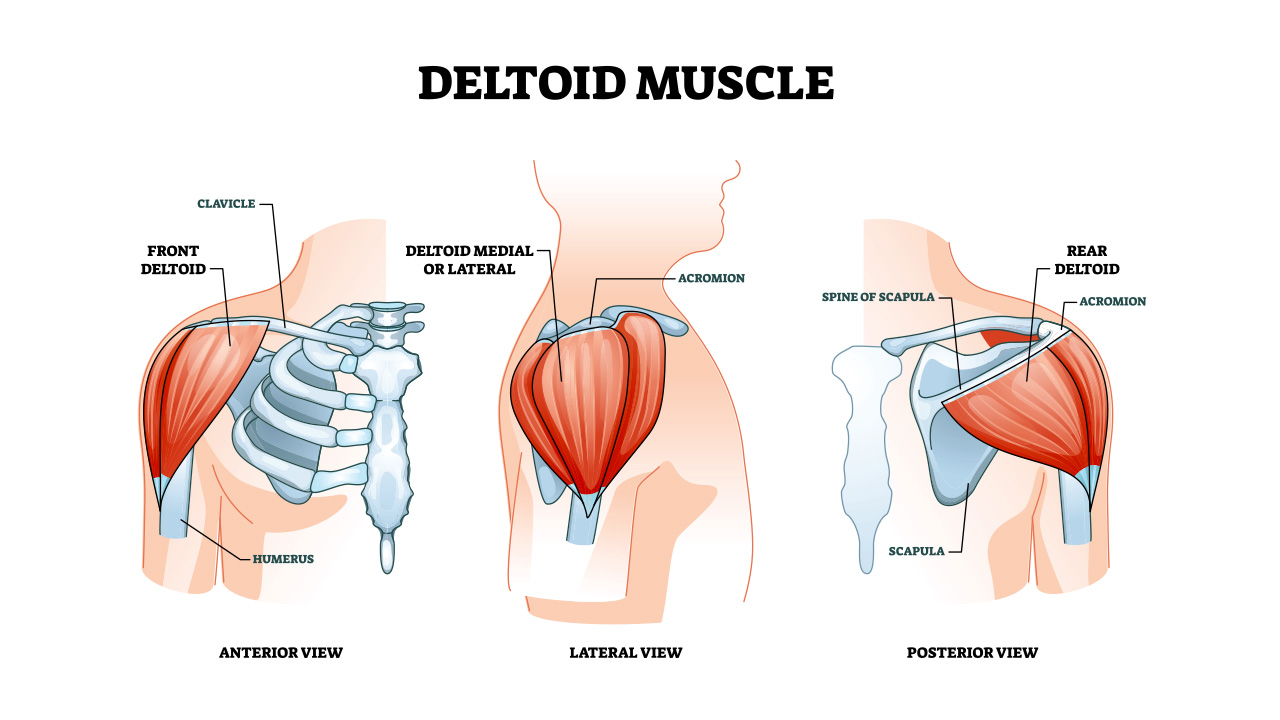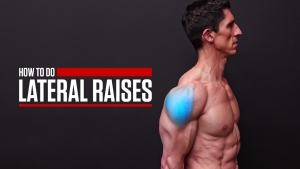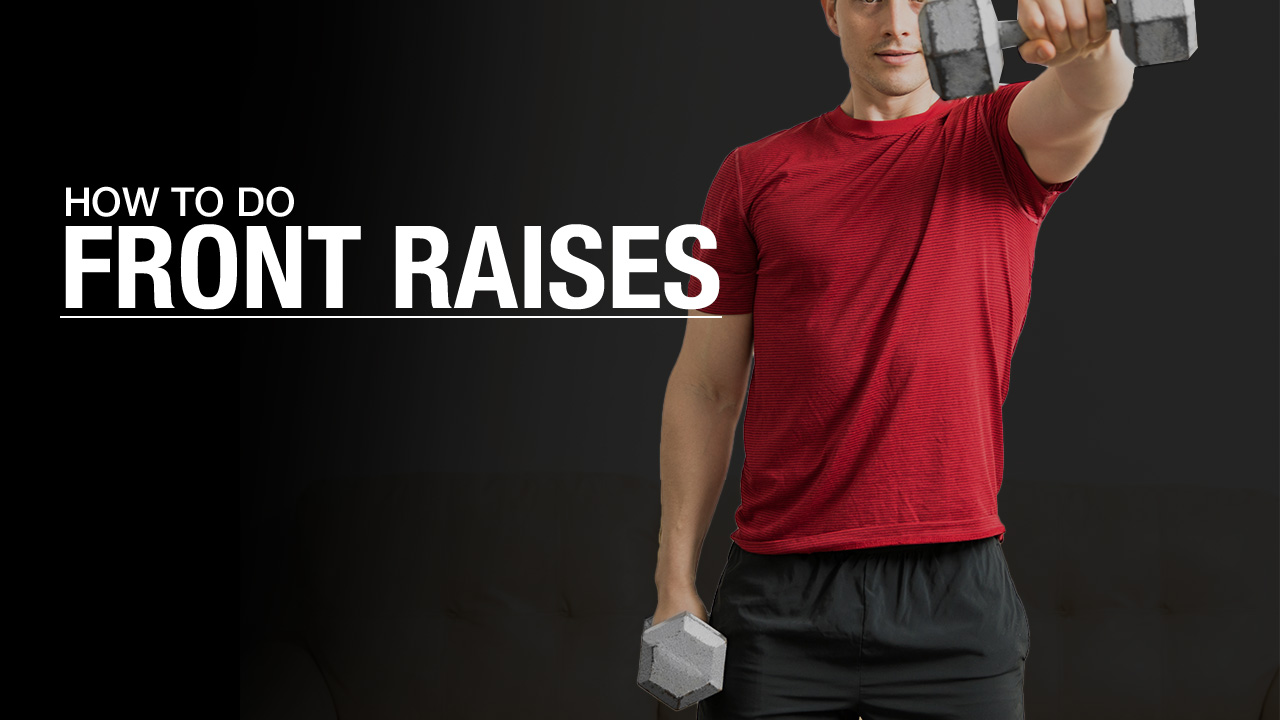
WHY FRONT RAISES ARE IMPORTANT
Alright, let’s kick things off with a little reality check, guys.
When it comes to shoulder workouts, most people think they’re covered by just hammering out a few sets of Bench Presses.
Sure, Bench Presses are great for your chest and can give your front delts some action, but if you really want to develop those front deltoids, you need to give them the attention they deserve with effective shoulder exercises.
Ignoring direct front delt work is a common mistake that can lead to imbalances, shoulder pain, and missed gains.
Bench Presses alone won’t cut it if you’re aiming for strong, well-rounded shoulders.
That’s why today, we’re diving into one of the most effective exercises for your front delts: the Front Raise.
This move is key for isolating those front delts and ensuring they’re getting the targeted work they need.
We’ll break down the proper form, starting position, and all the technique tips you need to maximize your gains and avoid injuries.
So, grab a pair of dumbbells, and let’s get those front delts firing on all cylinders.
ANATOMY OF THE DELTS
Let’s dive into the anatomy of the delts and why building a strong mind-to-muscle connection is crucial for effective shoulder workouts.
Understanding your shoulder muscles can make a massive difference in your gains and help prevent injuries.
When you focus on that connection, you ensure every rep counts, maximizing strength and muscle growth.
Let’s break down each part of your delts and see how to get the most out of your shoulder exercises.
FRONT DELTS
Your front deltoids, or anterior delts, are part of the trio that make up your shoulder muscles.
Think of them as the front soldiers in your shoulder army. They start at your clavicle – that’s your collarbone for those who skipped anatomy class – and they stretch down to the humerus, which is your upper arm bone.
Now, why do we care about these muscles?
The front delts are the MVPs when it comes to lifting your arm forward, a key motion for an exercise for shoulder flexion. Whether you’re reaching out to grab something from a shelf at shoulder height, throwing a punch, or providing assistance in Bench Presses, the front delts are the ones doing the heavy lifting.
They also play a big role in stabilizing your shoulder joint, keeping everything in place when you’re pressing, lifting, or even just moving your arms around.
This stabilization is crucial for maintaining shoulder health and avoiding shoulder impingement.
So, when you’re hitting those Dumbbell Front Raises, you’re not just working for those aesthetic gains – you’re also building strength and stability that will help you in tons of everyday activities and other lifts.
MIDDLE DELTS
Your middle deltoids, or lateral delts, are key players in your shoulder muscles, giving you that wide, sculpted look.
These delt shoulder muscles originate from the acromion – the bony part of your shoulder blade – and insert into the humerus, your upper arm bone.
The middle delts are important for shoulder abduction, lifting your arms out to the sides, and giving your shoulders that broad appearance. When you perform a Dumbbell Lateral Raise, you’re isolating these muscles to build strength and size, contributing to overall upper body strength.
Proper form is essential for maximizing gains and preventing injuries, especially during involvement in Shoulder Presses.
Incorporating Lateral Raises and other raise variations into your shoulder routine can help build strong shoulders, improve shoulder health, and enhance your workout routine.
Use light weights initially and gradually increase as you master the technique.
This isolation exercise should be a staple in your hypertrophy training program for effective shoulder workout and to avoid shoulder impingement syndrome.
REAR DELT
Your rear deltoids, or posterior delts, are essential for strong shoulders and balanced upper body strength.
These delt shoulder muscles originate from the spine of your shoulder blades and attach to the humerus, your upper arm bone.
Rear delts are vital for shoulder extension and external rotation, key for various shoulder exercises and shoulder health. Exercises like the Reverse Fly and Bent-Over Lateral Raise isolate these muscles to build strength and stability.
Proper form is crucial to avoid shoulder impingement and maximize gains. Start with lighter weights to master the technique, then gradually increase to heavier weights for strength gains. Rear delt exercises should be a staple in your hypertrophy training program for shoulder muscle development.
Use a neutral grip or overhand grip, maintain proper exercise technique, and avoid poor form to achieve massive shoulders and optimal shoulder movement. Incorporate rear delt exercises into your shoulder routine to enhance shoulder health and prevent shoulder injuries.
HOW TO DO FRONT RAISES
Front Raises are a key exercise for isolating and strengthening your front deltoids, essential for balanced and sculpted shoulders, development, and overall upper body strength.
And for those who have watched my video on Shoulder Exercises Ranked, you might remember that Front Raises are one of the best (and one of my favorite) exercises for your front delts.
By focusing on proper form and controlled movements, you can effectively target these muscles, enhance stability, and achieve better definition in your shoulders.
Here’s how to perform the Front Raise:
DUMBBELL FRONT RAISE

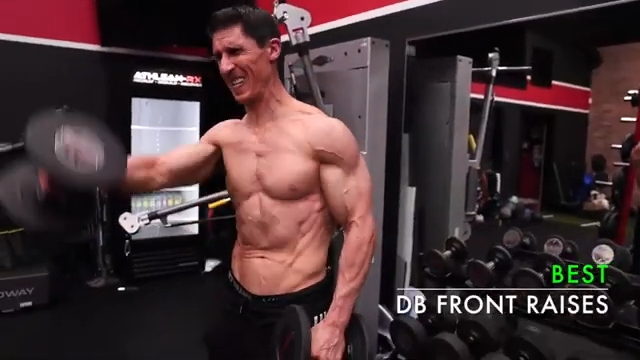
HOW TO DO THE DUMBBELL FRONT RAISE:
- Pick up a pair of dumbbells and position yourself with feet hip-width apart.
- Allow the dumbbells to rest straight down in front of your thighs, with your palms facing inward.
- Keep a slight bend in your knees and engage your core for added stability.
- Maintain a neutral head position with your chest up and shoulders back. This alignment helps protect your shoulder joints and prevents shoulder blade tension.
- With a slight bend in your elbows, raise the dumbbells through an upward movement in front of you, targeting your shoulder flexor muscles. Lift until your arms are parallel (or above parallel) to the ground at shoulder height.
- Slowly lower the dumbbells back to the starting position, maintaining tension in your front delts.
- Control the descent to avoid poor form and prevent shoulder joint injuries. Focus on a slow, controlled motion to maximize muscle engagement.
- Repeat for the desired number of reps, typically within a 10-15 rep range.
- Emphasize quality over quantity to prevent poor technique and achieve effective results. Incorporate this exercise into your upper body workout routine for balanced shoulder muscle development.
WHAT MAKES IT EFFECTIVE: Front Raises are highly effective because they isolate and target the front deltoids, enhancing shoulder strength, stability, and definition when performed with proper form and controlled motion.
ECCENTRIC OVERLOAD: KEY TO BIGGER DELTS
Now that you know how to perform a standard Front Raise, I want to talk about building bigger front delts with eccentric overloading.
This technique focuses on creating tension through effectively stretching the muscle and promoting growth.
One common issue with delt training is that many exercises don’t place the front delts under enough stretch during the range of motion.
Think about it: when you do an Overhead Press, your front delts don’t experience much stretch unless you go way down low, which can risk shoulder injury.
But here’s the good news: you don’t need fancy machines to achieve this.
All you need is a bench and a pair of dumbbells or resistance bands.
By adjusting the bench to an incline and understanding that the function of the shoulder is to flex or raise the arm in front, you can effectively stretch the front delts.
Here’s how you do it:
INCLINE BENCH FRONT RAISE

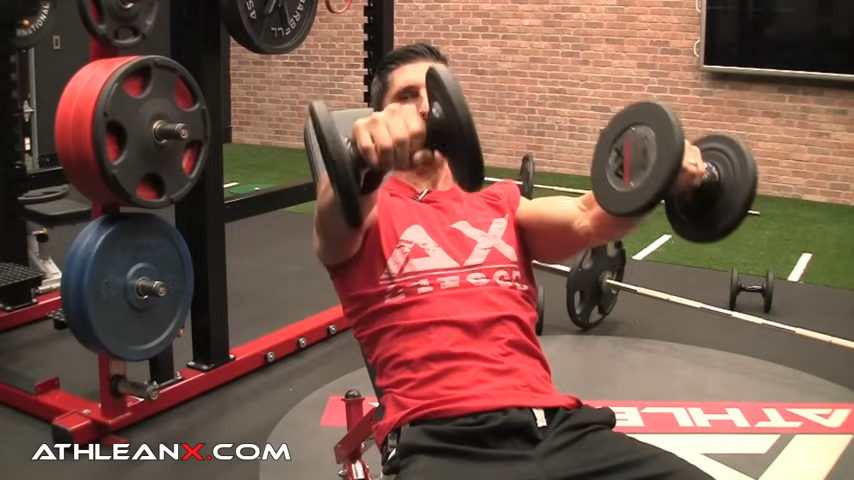
HOW TO DO THE INCLINE BENCH FRONT RAISE:
- Position an incline bench at about a 30-degree angle from vertical.
- Lean back on the bench with a pair of dumbbells. Your arms should extend behind your body, creating an initial stretch on the front delts.
- Perform the Front Raise by bringing the dumbbells up in front of you. Focus on maintaining tension throughout the movement.
- As you lower the dumbbells, keep the tension constant. This eccentric phase is crucial – don’t let the weights swing or drop. Fight the resistance all the way down to maximize the stretch and tension.
WHAT MAKES IT EFFECTIVE: You’ll notice a significant difference in how your front delts feel and respond to this exercise. Even the Journal of Strength and Conditioning Research backs this technique up. The Incline Dumbbell Raise allows for continuous tension and stretch that will challenge your muscles in a way they probably haven’t been before, leading to greater strength and growth.
By incorporating eccentric overloading with this Incline Bench Front Raise, you ensure that your front delts are getting the targeted, effective work they need.
This method is a surefire way to enhance your shoulder training and achieve those bigger, stronger front delts you’re aiming for.
FRONT RAISES COMMON MISTAKES
Alright guys let’s talk about some common mistakes that can ruin your front raises and set back your gains.
Making sure you avoid these errors will not only help you achieve better results but also keep you injury-free. Here are the top mistakes and how to fix them:
USING TOO MUCH WEIGHT
One of the biggest mistakes is trying to lift too heavy weights. It’s tempting to grab the heaviest dumbbells or weight plates, but this often leads to poor technique and excessive form breakdown.
Start with a bit of weight that allows you to maintain strict form and gradually increase as you build strength.
INCORRECT STARTING POSITION
Your starting position is crucial. Stand with your feet shoulder-width apart and keep your body stationary. Avoid leaning back or swinging the weights up. A proper stance helps maintain balance and focus on your front delts.
POOR GRIP POSITION
Your grip positions are crucial for effective front raises. Always use a neutral or overhand grip, keeping your palms facing down.
Many lifters make the mistake of turning the dumbbells inward as they lift, almost like they’re pouring water.
This “pouring” action shifts the focus away from your front delts and puts unnecessary strain on your shoulder joints and shoulder blade.
Instead, keep your wrists straight and the dumbbells parallel throughout the entire range of motion.
This ensures that the front delts are properly engaged, minimizing shoulder blade tension, and maximizing muscle activation.
Remember, a proper grip maintains the alignment and balance necessary for an effective workout, helping to prevent injuries and improve overall performance.
INADEQUATE CONTROL OF MOTION
Don’t let the weights drop quickly. Control the motion for weight descent to maintain constant tension in your shoulder muscle fibers.
This is where many lifters go wrong, leading to potential shoulder joints injuries.
NEGLECTING THE ECCENTRIC PHASE
Remember what we talked about above? Time under tension is key for muscle growth. Focus on the eccentric phase by slowly lowering the weights.
This period of time is essential for maximizing gains and preventing shoulder tendons from overloading.
IMPROPER NECK POSITION
Keep a neutral head position to avoid straining your neck. Looking up or down can lead to neck pain and distract from the exercise.
LACK OF CORE ENGAGEMENT
Engage your abdominal muscles and pectoralis major (pectoral muscles or pecs) to stabilize your upper body.
This not only helps in maintaining balance but also in reducing the risk of shoulder tears and injuries.
INCORRECT RANGE OF MOTION
For optimal front raise success, it’s crucial to avoid lifting the weights too high or too low.
Aim to raise the dumbbells to shoulder level or slightly above, ensuring a full range of motion without overextending.
This precision helps maximize the effectiveness of the exercise while protecting your shoulders from unnecessary strain.
IGNORING RAISE VARIATIONS
Incorporate different raise variations like Plate Front Raises, Incline Dumbbell Raises, or a Raise with Cables to keep your workout routine diverse.
These variations can hit your delts from different angles and prevent muscle adaptation.
SKIPPING PROPER EXERCISE TECHNIQUE
Always prioritize proper exercise technique over lifting heavier weights.
Following ideal form and form tips helps in achieving better results and prevents injuries.
Incorporate Front Raise programming tips into your exercise program to ensure you’re on the right track.
And that’s your full guide on how to do traditional Front Raises.
Remember, guys: Using proper form with a neutral position and a slight bend in the elbows can help avoid shoulder injuries and maximize your shoulder routine.
Incorporate this fundamental weight training exercise into your program to achieve strong shoulders and improve your overall upper body workout.
If you’re looking for comprehensive programs that integrate exercises at the optimal times, explore our collection of ATHLEAN-X workouts.

- Bench Presses alone won’t cut it for strong, well-rounded shoulders.
- Focus on Front Delt Raises, direct front delt work is essential to avoid imbalances and shoulder pain.
- Here’s how to perform the Dumbbell Front Raise:
- Stand with your feet about shoulder width, holding a pair of dumbbells at arm’s length in front of your thighs, palms facing inward.
- Keep a slight bend in your knees, engage your core, and maintain a neutral head position with your chest up and shoulders back to protect your shoulder joints.
- With a slight bend in your elbows, lift the dumbbells in front of you until your arms are parallel to the ground at shoulder height, focusing on your shoulder flexor muscles.
- Slowly lower the dumbbells back to the starting position, maintaining tension in your front delts. Control the descent to avoid poor form and prevent shoulder injuries.
- Aim for a 10-15 rep range per set, focusing on quality over quantity to ensure proper technique and effective muscle engagement.
- Incorporate this into your upper body workout for balanced shoulder development.
HOW TO DO FRONT RAISES FAQS
Front raises primarily target the front deltoids, or anterior delts, which are the muscles on the front of your shoulders.
These muscles are crucial for shoulder flexion – that’s lifting your arm in front of you – and play a big role in stabilizing your shoulder joint during various movements.
You'll also get some secondary engagement in your upper chest and trapezius muscles, making it a great addition to your upper body workout routine.
Both Front Raises and Lateral Raises have their place in a balanced shoulder workout.
Front raises focus on the front delts, giving you that strong, defined look from the front.
Lateral Raise movements, on the other hand, target the middle deltoids, which are key for creating width and that coveted "V" shape.
So, it's not about which one is better – it’s about incorporating both to ensure you’re hitting all parts of your shoulder muscles effectively.
While Front Raises primarily target the front delts, they don’t directly work the back muscles.
However, having strong front delts can contribute to overall shoulder stability, which is beneficial for back exercises and overall upper body posture.
For direct back work, you’ll want to include exercises like Rows, Pull-Ups, and Deadlifts in your routine.
No, Front Raises don’t need to be done with heavy weights to be effective, especially if you have a current shoulder injury.
In fact, going too heavy can lead to poor form and increase the risk of shoulder injuries and shoulder surgery.
It’s all about using a weight that allows you to maintain strict form and full range of motion.
Focus on controlled movements and keep the tension on the front delts throughout the exercise.
Aim for a weight that lets you perform within a 10-15 rep range with good form, emphasizing quality over quantity.
REFERENCES

Jeff Cavaliere M.S.P.T, CSCS
Jeff Cavaliere is a Physical Therapist, Strength Coach and creator of the ATHLEAN-X Training Programs and ATHLEAN-Rx Supplements. He has a Masters in Physical Therapy (MSPT) and has worked as Head Physical Therapist for the New York Mets, as well as training many elite professional athletes in Major League Baseball, NFL, MMA and professional wrestling. His programs produce “next level” achievements in muscle size, strength and performance for professional athletes and anyone looking to build a muscular athletic physique.
















